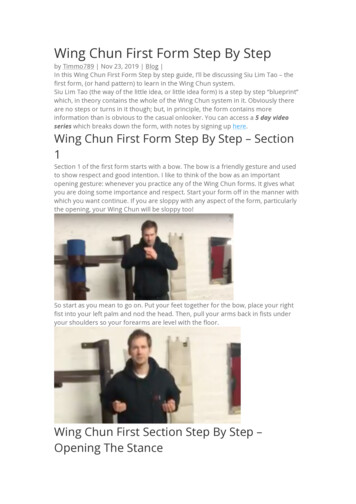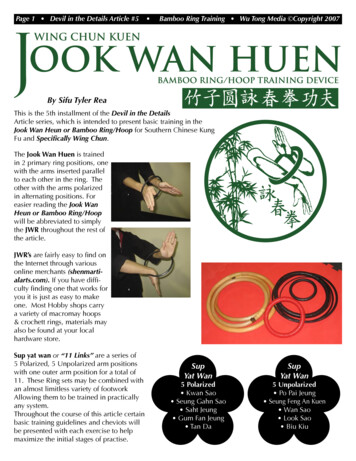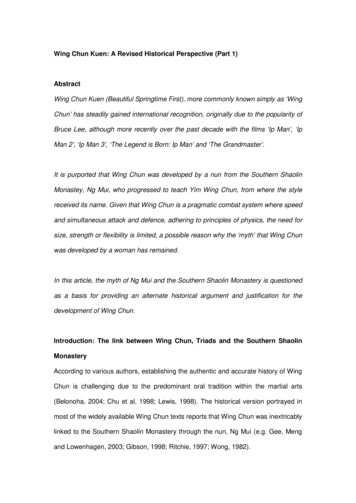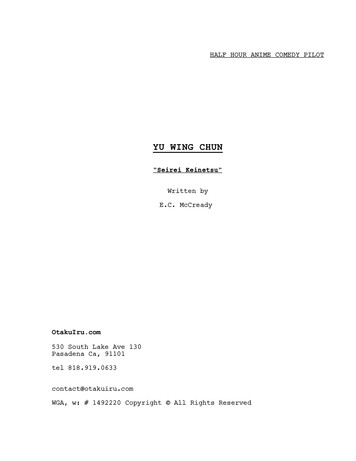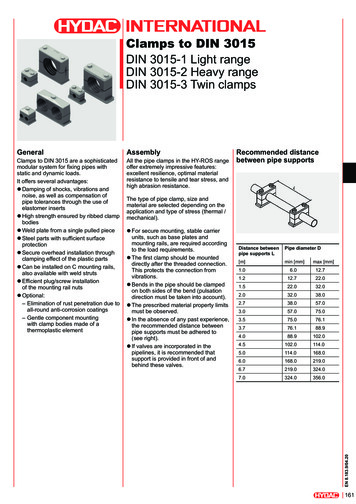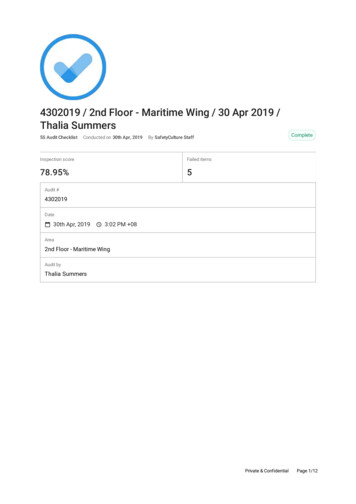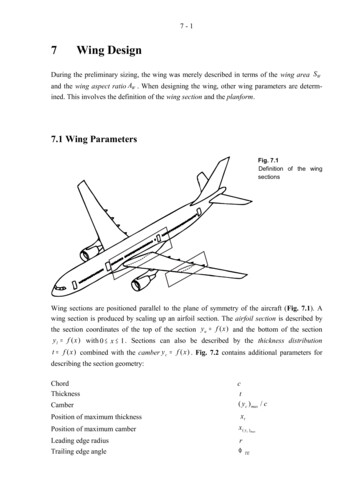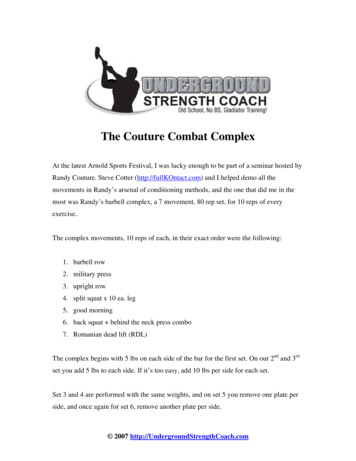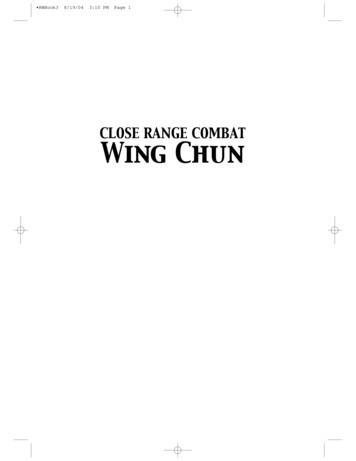
Transcription
RWBook38/19/043:10 PMPage 1CLOSE RANGE COMBATWing Chun
RWBook38/19/043:10 PMPage 2
RWBook38/19/043:10 PMPage 3CLOSE RANGE COMBATWing ChunMook Yan Joang(Wooden Man Dummy Form,Drills and Applications)Volume 3Randy WilliamsUNIQUE PUBLICATIONSBurbank, California
RWBook38/19/043:10 PMPage 4DisclaimerPlease note that the author and publisher of this book are NOTRESPONSIBLE in any manner whatsoever for any injury that may resultfrom practicing the techniques and/or following the instructions givenwithin. Since the physical activities described herein may be too strenuous in nature for some readers to engage in safely, it is essential that aphysician be consulted prior to training.First published in 2004 by Unique Publications.Copyright 2003 by CFW Enterprises, Inc.All rights reserved. No part of this publication may be reproduced or utilized in any form or by any means, electronic or mechanical, includingphotocopying, recording, or by any information storage and retrieval system, without prior written permission from Unique Publications.Library of Congress Catalog Number: 2002ISBN:Unique Publications4201 Vanowen PlaceBurbank, CA 91505(800) 332–3330First edition05 04 03 02 01 00 99 98 97 1 3 5 7 9 10 8 6 4 2Printed in the United States of AmericaEditor: John S. SoetDesign: Patrick GrossCover Design: George Chen
RWBook38/19/043:10 PMPage 5DedicationThis series of books is dedicated to the memory of two favorite CRCAmembers from the past; Paul Green, whom we tragically lost on May 18,2001, during the production of this book and Larry Jordan, a good friendand student who loved the art of Wing Chun and is still sorely missedtwenty years later by all of us who knew him.Also during the production of this book, my very good friend GuySeiji Kurose passed away. He was a 6th degree black belt in Goju-RyuKarate and was best known for his dedication to children and youth, aswell as his high spirit, laughter, and quickness of mind.Guy S. Kurose1952–2002Lawrence A. Jordan1956–1982Paul M. Green1969–2001
RWBook38/19/043:10 PMPage 6
RWBook38/19/043:10 PMPage 7ContentsFOREWORD BY PROF. DANIEL LEE . . . . . . . . . . . . . . . . . . . . . . . . . . . . . . 8WOODEN MAN . . . . . . . . . . . . . . . . . . . . . . . . . . . . . . . . . . . . . . . . . . 10MOOK YAN JOANG . . . . . . . . . . . . . . . . . . . . . . . . . . . . . . . . . . . . . . . . 13DUMMY STRUCTURE . . . . . . . . . . . . . . . . . . . . . . . . . . . . . . . . . . . . . . 15BUILDING AND INSTALLING THE DUMMY . . . . . . . . . . . . . . . . . . . . . . . . 21WOODEN DUMMY PLANS . . . . . . . . . . . . . . . . . . . . . . . . . . . . . . . . . . . . . . 24PRELIMINARIES . . . . . . . . . . . . . . . . . . . . . . . . . . . . . . . . . . . . . . . . . . 31BENEFITS OF WOODEN DUMMY TRAINING . . . . . . . . . . . . . . . . . . . . . . . 35THE “108” . . . . . . . . . . . . . . . . . . . . . . . . . . . . . . . . . . . . . . . . . . . . 39THE EIGHT KICKS AND THE WOODEN DUMMY . . . . . . . . . . . . . . . . . . . . 43WOODEN DUMMY FORM (PART I) . . . . . . . . . . . . . . . . . . . . . . . . . . . . 49WOODEN DUMMY FORM (PART II) . . . . . . . . . . . . . . . . . . . . . . . . . . . 101MOOK YAN JOANG FOT YUT LING BOT FORM SEQUENCE . . . . . . . . . . . 137MAIN POINTS OF WOODEN DUMMY TRAINING . . . . . . . . . . . . . . . . . . 143SAN SAU—PRACTICAL APPLICATIONS . . . . . . . . . . . . . . . . . . . . . . . . . 145PART I . . . . . . . . . . . . . . . . . . . . . . . . . . . . . . . . . . . . . . . . . . . . . . . . . . 146PART II . . . . . . . . . . . . . . . . . . . . . . . . . . . . . . . . . . . . . . . . . . . . . . . . . . 191“YUT DING FOT” . . . . . . . . . . . . . . . . . . . . . . . . . . . . . . . . . . . . . . . 233WOODEN DUMMY DRILLS . . . . . . . . . . . . . . . . . . . . . . . . . . . . . . . . . 237IRON PALM . . . . . . . . . . . . . . . . . . . . . . . . . . . . . . . . . . . . . . . . . . . 249EFFECTS OF IRON PALM TRAINING . . . . . . . . . . . . . . . . . . . . . . . . . . . 253THE IRON PALM TRAINING SEQUENCE . . . . . . . . . . . . . . . . . . . . . . . . . 259THE TEN IRON HAND MOTIONS . . . . . . . . . . . . . . . . . . . . . . . . . . . . . 263IRON PALM TRAINING TABLE PLANS . . . . . . . . . . . . . . . . . . . . . . . . . . . . . . 268ACKNOWLEDGEMENTS . . . . . . . . . . . . . . . . . . . . . . . . . . . . . . . . . . . . 269
RWBook38/19/043:10 PMPage 8ForewordWing Chun Kung Fu is regarded as oneof the most scientific Chinese fightingsystems in the world. This combat system is known for its speed and simplicity. It is brutally effective in close rangecombat, stressing economy in motionand centerline attacks.To receive the proper training inWing Chun, a student must start withthe training of Siu Leem Tau, the firsthand form, and learn to execute all thebasic hand techniques in a stationary,toe-in, pyramid stance. The he progresses to Chum Kiu, the second form,in order to develop agility, mobility, andbalance through stance pivoting andcombination of hand and foot techniques. After mastering the two-handforms, the student is then ready to launch into the training of Mook YanJoang, the Wooden Dummy form, as well as Chi Sao, sticking-hand training. Later, he can further his training in Wing Chun weapons—the WingChun Butterfly Knives and the Six-and-a-Half-Point Pole.My exposure to Wing Chun Kung Fu started in an unusual way. Iwas fortunate to have studied the art of Jeet Kune Do (JKD) with BruceLee in 1967 at his Los Angeles Chinatown school. I noticed that the corematerial and terminologies used in JKD were all derived from WingChun. When I practiced Chi Sau with Bruce, I experienced his marvelouspliable and explosive energies, which he had acquired through years oftraining in Wing Chun. It was then that I decided that I would take upWing Chun some day. I continued my JKD training even after Bruce’suntimely death in 1973. It was in 1980 that I had the good fortune tostart my formal Wing Chun training with Sifu Jim Lau, a well-knownWing Chun teacher in the Los Angeles area, and I still practice what Ihave learned to this date.In my experience, a student who wishes to learn Wing Chun KungFu must look for a qualified teacher. Sifu Randy Williams is such ateacher who comes from a solid lineage and has had many years of experience. He has written extensively on Wing Chun Kung Fu and is wellknown for his training video programs. I am impressed with his skills in8
RWBook38/19/043:10 PMPage 9Wing Chun Kung Fu and his ability to teach Wing Chun in a clear andsystematic way. There are books written on the three Wing Chun formsand on the Wooden Dummy set, but there had not been a single bookwritten that covers the entire Wooden Dummy set until Sifu Williamspublished his first book. He has finally completed his long awaited second edition of his book on the complete 108-form Wooden Dummy set.The book is based on his years of research and personal training. Thebook offers clear photographs of each movement, couple with the topview of the foot position with reference to the Wooden Dummy. In addition, the Cantonese pronunciation and description of each movement isclearly given. It is a detailed and comprehensive training manual for students who want to seriously study the Wooden Dummy set. It has been avaluable reference manual for me personally. I want to congratulate SifuWilliams for his monumental work and for his contribution to theadvancement fo Wing Chun Kung Fu in the martial arts world. I highlyrecommend that all Wing Chun students add this wonderful book to theirmartial-arts library.—Prof. Daniel Lee9
RWBook38/19/043:10 PMPage 1010
RWBook38/19/043:10 PMPage 11Wooden ManMook Yan Joang Fot Yut Ling BotThere are one hundred and eight Wooden Dummy techniques.Doh Leen Ging Lick Duck Kay FotRepeated practice brings proper use of energy and power.Lick Yau Sum Fot Sheh Joang SumPower comes from the heart and shoots straight to the core of the Dummy.Boh Ying Juen Woon Chuen Joang SunFootwork varies while maintaining close proximity to the body of the Dummy.Syeung Ha Woang Loy Yau Jeep DeetMovements go upward, downward, back and forth with continuity.Goang Lick Jahng Kyeung Lahng Chock ShuenImprovement of strength and power cannot be accurately gauged.Kiu Chee Joang Sau Sick Joke HahngThe Arm Bridge sticks to the arm of the Dummy while moving.Chee Ging Leen Sing Wai Lick SahngSticking power, when achieved, is a commanding force.Ging Lick Fot Duck Yee Sum YuenPower and energy can be released as intended.Seen Wai Yoang Duck Hoh Lahng ChueUse of the Centerline will be proper and therefore hard to defeat.11
RWBook38/19/043:10 PMPage 12
RWBook38/19/043:10 PMPage 13Mook Yan JoangJoang Sau, literally “Dummy Hand,” is the Chinese term for the techniques of the Mook Yan Joang, or “Wooden Man Dummy.” The MookYan Joang is a training device used by many different styles of ChineseGung Fu such as Choy Lay Fut and Praying Mantis, but is probably mostoften identified with the Wing Chun system.The first form of Wooden Man was used in the Shaolin temple ofancient China, where legend has it that in order to graduate from the temple, a disciple had to fight his way out through a complex maze of 108 different Wooden Dummies, some of which were spring-loaded and couldinflict fatal injury if not dealt with correctly, others which were mechanically operated by concealed onlookers. It is even rumored that some ofthe Wooden Men were actually elder monks wearing wooden armor.13
RWBook38/19/043:10 PMPage 14Close Range Combat Wing Chun: Volume ThreeFig. 236—AnotherChinese Gung Fusystem that uses aWooden Dummy aspart of its training program is the Choy LayFut style. The BalanceDummy is one of afew different typesused by Choy Lay Futpractitioners.14
RWBook38/19/043:10 PMPage 15Dummy StructureFig. 237—The Wing Chun Wooden Dummy.Various Gung Fu styles use the Wooden Man differently, and the actualDummy itself will vary in size, shape and configuration depending on thestyle using it. The Wing Chun Wooden Dummy is constructed from around hardwood post 4’7” tall and 8”-9” in diameter. This post serves asa trunk, which is suspended in air by two horizontal crossbeams thatpass through it and hold it at the proper level as determined by the heightof the individual trainee. These beams should be made of a resilientwood during the early phases of Wooden Dummy training. As the practitioner becomes more accustomed to contact with the hardwood Dummyarms and leg, the crossbeams can be replaced with metal bars thatreduce the amount of “play” and recoil of the Dummy when hit.The Wooden Man has three arms set at strategic angles and one legthat extends from its center. The tenons attached to the arms and leg are15
RWBook38/19/043:10 PMPage 16Close Range Combat Wing Chun: Volume Threefitted loosely within square mortised holes through the trunk. These holesare square to prevent rolling of the Dummy arm when it is hit and also toguide the trainee’s arm to snap the Dummy arm into whichever corner isappropriate for the technique being executed. For example, the BoangSau Wing Arm Deflection should snap the Dummy arm up into the highcorner opposite the Boang arm. The holes in the Dummy trunk throughwhich the horizontal crossbeams pass are also square for stability and toenable the trainee to smoothly snap each individual element squarely toits limit against the next with a correctly powered and angled technique.Thus, the same Boang Sau not only snaps the Dummy arm to its limit ofmotion within the square arm hole, but if correct snap and leverage isapplied, the entire Dummy trunk will make a short arcing pivot on itsMotherline, until the front vertical side of the trunk hole opposite theBoang arm snaps squarely against the front face of the horizontal crossbeam. To illustrate this point, a simple experiment can be performed:Put one palm on each side of the head area of the Dummy trunk.Holding the trunk firmly between the hands, twist the Dummy to the leftand right and note that it is able to pivot on its Motherline to the pointwhere the front of one side of the trunk hole and the rear of the other sidereach their limits (the crossbeam).Other elements in the “linkage” of the Dummy structure are the pinsthat prevent the arms and leg from being pulled completely out of theDummy by grabbing or jerking hand techniques and hooking legmotions. Because the pins do not hold the Dummy arms tightly againstthe trunk, in motions without Yin/Yang Structure created by a stancepivot, the pin can substitute for the corner of the arm hole, allowing theDummy arm to be pulled a short distance out from the Dummy trunkbefore snapping to its limit. For example, the Syeung Loy Jut Sau motionseen repeatedly throughout the form first pulls the two upper Dummyarms to their forward limit (the pins) and then the entire Dummy trunkforward to its limit as the rear insides of the square trunk holes snapsquarely against the rear faces of the two horizontal crossbeams.Similarly, the double Pau Jyeung motion that follows first snaps theDummy arms back to their backward limit and then pushes the Dummytrunk back to the point where the front inside faces of the trunk holessnap flat against the front faces of the crossbeams. Due to the multidirectional nature of Wing Chun power, each Dummy technique shouldsnap the arm tenon(s) to either side of the armhole mortise(s) or pin(s),and the entire Dummy trunk to its limit of forward, backward or pivotingmovement on the horizontal crossbeams. Any technique that fails to dothis is either incorrectly executed, insufficiently powered, or both.Each part of the Dummy represents one or more parts of the human16
RWBook38/19/043:10 PMPage 17Dummy Structureanatomy, depending on the technique being practiced. For example, theDummy’s low arm can alternately simulate a low punch, a mid-level kickor the groin area for kicking attacks. In this way, the Dummy represents
Chun. When I practiced Chi Sau with Bruce, I experienced his marvelous pliable and explosive energies, which he had acquired through years of training in Wing Chun. It was then that I decided that I would take up Wing Chun some day. I continued my JKD training even after Bruce’s untimely death in 1973. It was in 1980 that I had the good fortune to
